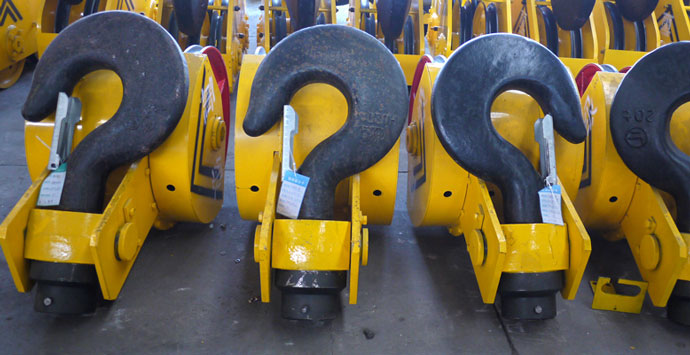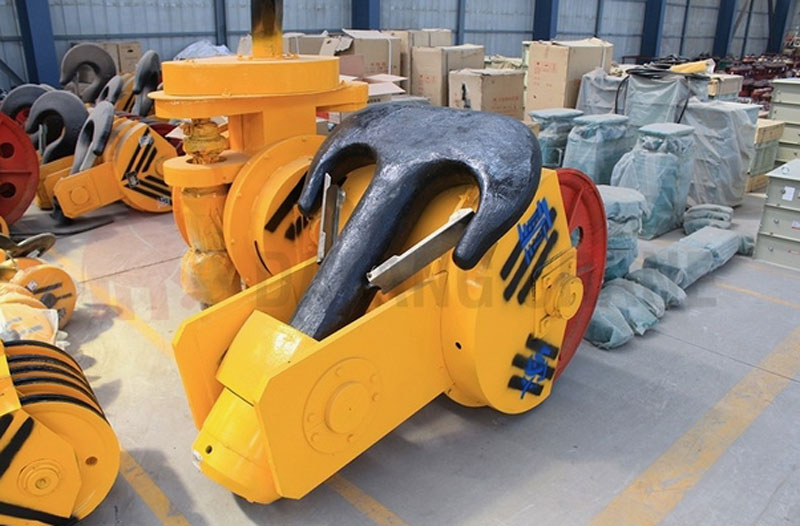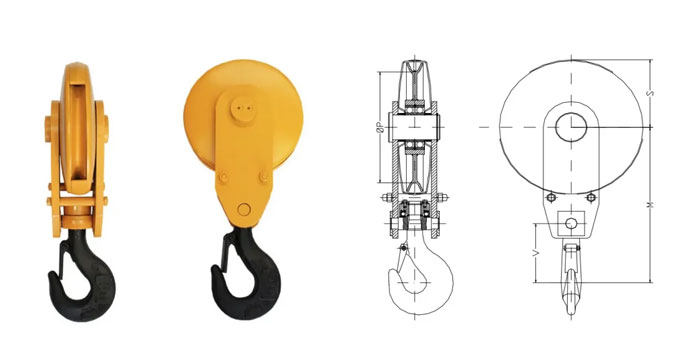В требовательном мире подъемных работ, безопасность – это не просто приоритет, это абсолютная основа. Критически важный компонент, который часто воспринимается как нечто само собой разумеющееся, но жизненно важно для предотвращения катастрофических аварий, это Защелка по обеспечению безопасности крюка. Обеспечение соответствия этого небольшого, но мощного устройства требованиям OSHA не является обязательным.; это юридический и моральный императив. В этом руководстве подробно рассматривается, что делает защитную защелку соответствующей требованиям OSHA и почему она важна для каждого лифта..

Представьте себе подвешенный груз, соскальзывающий с крюка.. Последствия – материальный ущерб, тяжелая травма, или даже фатальность – немыслимы. Основная функция предохранительной защелки – предотвратить именно это.: удержание груза в горловине крюка, действуя в качестве решающего барьера против случайного разъединения, вызванного:
1. Ослабление или смещение стропа/груза.
2. Зацепляясь за препятствия.
3. Неожиданное движение или вибрация.
4. Ошибка оператора во время позиционирования.

Управление по охране труда (Оша) устанавливает стандарты безопасности на рабочем месте в США. Основные правила, регулирующие крановые крюки и защелки, включают::
2. Оша 29 CFR 1926.1431(с)(2)(я): Настоящие правила применяются конкретно к кранам и вышкам в строительстве.. Он требует: Крючки (кроме ручных крючков) и защелки… должны иметь достаточный вес, размер, и форма, предотвращающая случайное соскальзывание груза с крюка..
Просто иметь *защелку* недостаточно. Должна быть установлена защитная защелка, соответствующая требованиям OSHA.:
1. Подарок: Устанавливается на крюке в стандартной комплектации..
2. Функциональный: Работайте правильно – автоматически закрывается через горловину и остается надежно зафиксированным при нормальных условиях подъема.. Его не следует легко открывать под действием груза или такелажа..
3. Соответствующий: Размер и конструкция специально разработаны для крюка, к которому он прикреплен, и подходят для типов используемых грузов и оснастки..
4. Поддерживается: Без повреждений (трещины, чрезмерный износ, изгиб, недостающие пружины) это помешало бы ему выполнять свою функцию безопасности. Защелки должны двигаться свободно, без заеданий..
5. Используется правильно: НИКОГДА намеренно отключен, привязанный назад, или удалено. Инспекторы OSHA часто называют это нарушением.. Защелке необходимо дать возможность выполнять свою работу – закрывать груз..
6. Обеспечение эквивалентной защиты (если защелка не используется): Если полагаться на исключение (1910.179(б)(4)(ii)), альтернативный метод (мышь, штифт дужки, и т. д.) должен явно предотвращать случайное расцепление так же эффективно, как и правильно функционирующая защелка.. Документация, подтверждающая эту эквивалентность, имеет важное значение..

Будьте бдительны и избегайте этих частых цитат.:
Отсутствующие защелки: Крюки поставляются или эксплуатируются без установленной защелки..
Поврежденные или неработоспособные защелки: Погнутые защелки, недостающие пружины, защелки, которые не закрываются автоматически, или застряли в открытом состоянии.
Отключенные защелки: Защелки намеренно подключены, связанный, зажатый, или иным образом держится открытым.
Отсутствие эквивалентной защиты: Использование крючков без защелок в ситуациях, когда не используется явно эквивалентный метод безопасности..
Неправильное соответствие крюка/защелки: Использование защелки, не предназначенной для конкретного размера или типа крючка..
1. Проверка перед использованием: Внесите тщательную визуальную и функциональную проверку крюка И предохранительной защелки в список ежедневных предпусковых проверок.. Ищите повреждения, носить, и убедитесь, что он закрывается свободно и надежно.
2. Регулярное техническое обслуживание & Осмотр: Включайте крючки и защелки в периодические (ежемесячно, ежеквартальный, ежегодно) комплексные проверки, выполняемые квалифицированным персоналом. Следуйте рекомендациям производителя и стандартам ASME B30.10..
3. Немедленное отстранение от службы: Любой крючок с отсутствующим, поврежден, или неисправную защелку необходимо немедленно пометить и вывести из эксплуатации до тех пор, пока она не будет должным образом отремонтирована или заменена..
4. Никогда не отключайте защелку: Установите строгую культуру безопасности, в которой отключение защелки недопустимо.. Обучите операторов и монтажников критической важности защелки.
5. Правильное обучение: Обеспечить весь персонал, участвующий в работе крана., такелаж, и сигнализации понимать требования OSHA в отношении крючков и защелок, как их проверить, и опасности их обхода.
6. Документация: Ведение учета проверок, обслуживание, ремонт, и любое обоснование использования крючков без защелки в соответствии с положением об исключении.
Предохранительная защелка крюка крана – это небольшой компонент, несущий огромную ответственность.: обеспечение безопасности вашего груза и безопасности ваших сотрудников. Соблюдение требований OSHA – это не бюрократия; речь идет о внедрении проверенных, эффективные меры по предотвращению разрушительных аварий. Обеспечивая постоянное наличие защелок безопасности, функциональный, поддерживается, и правильно использовать, вы выполняете фундаментальное юридическое обязательство и, что еще более важно, защитить жизни всех на вашем рабочем месте. Никогда не стоит недооценивать силу этой маленькой защелки – сделайте ее соблюдение краеугольным камнем вашей программы безопасности при подъеме..


1 квартал: Почему так важна предохранительная защелка на крюке крана?
А: Предохранительная защелка является критически важным устройством безопасности.. Это предотвращает слинги, веревки, или оборудование от случайного выскальзывания из горловины крюка во время подъемных операций.. Без этого, нагрузки могут отсоединиться из-за провисания, вибрация, зацепка, или ошибка оператора – приводящая к падению груза, материальный ущерб, тяжелые травмы, или смертельные случаи.
2 квартал: Требуются ли предохранительные защелки OSHA?
А: Да, за очень ограниченным исключением. OSHA Правила (29 CFR 1910.179(б)(5) для общей промышленности и 29 CFR 1926.1431(с)(2)(я) для строительства) предписать, чтобы крюки крана были оборудованы функциональными предохранительными защелками. Единственное исключение — если использование защелки создает большую опасность. (НАПРИМЕР., специализированные работы с ковшом/магнитом) ИЛИ, если эквивалентный метод (как мышь или закрепленный штифт дужки) обеспечивает равную защиту от разъединения. Работодатели должны строго обосновать любое исключение..
Q3: Что делает защитную защелку «соответствующей требованиям OSHA»?
А: Соответствующая защелка должна быть:
✅ Подарок (установлен на крючке).
✅ Функциональный (закрывается автоматически и остается включенным под нагрузкой).
✅ Правильное обслуживание (без повреждений, изгиб, трещины, или не хватает пружин).
✅ Правильное использование (никогда не отключался, привязанный назад, или удалено).
✅ Подходит для крючка & Нагрузка (правильный размер/тип).
Если в исключении не используется защелка, альтернативный метод должен обеспечивать явно эквивалентную безопасность.
Мы ценим ваши отзывы! Пожалуйста, заполните форму ниже, чтобы мы могли адаптировать наши услуги к вашим конкретным потребностям.


Нажмите кнопку, чтобы получить информацию о продукте и цитаты на WhatsApp.
Получите цитату
Последние комментарии